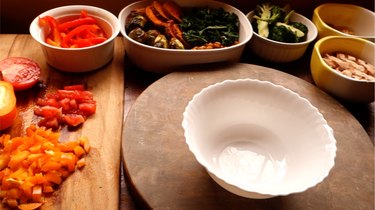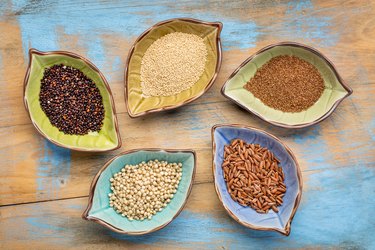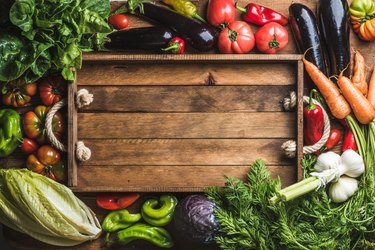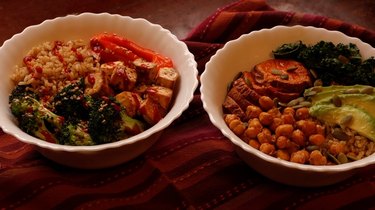Buddha bowls (a.k.a. hippie bowls) -- initially exclusive among the vegan and vegetarian community -- have now gone mainstream because of their power to both nourish and satisfy, boosting health and aiding weight loss efforts. Plus, they're delicious. Though there are some variations on the formula (some allowing for non-vegan ingredients), many agree that each bowl should be "built" according to a winning superfood equation: whole grain + a nutrient rich green/veggies + lean protein + healthy fats = happiness in a bowl.

Video of the Day
There are loads of Buddha bowl recipes online, but the greatest thing about these hearty meals is the ability to use the formula to create your own out of your favorite nutrient-dense foods. In fact, your kitchen may already have all the ingredients needed to create a winning combo!
Video of the Day
Things You'll Need
A bowl
A whole grain of your choice
A dark green vegetable
One or more additional vegetables (go for color!)
A lean protein
A healthy fat (can be in the form of nutritious dressings and toppers like seeds and nuts)
Flavor boosters like herbs, spices, natural sauces (optional)
A grateful heart (optional, but highly recommended)

Step 1: Choose a Healthy Whole Grain

Whole grains provide a healthy source of nutrients like fiber, B vitamins, and minerals. The fiber, in particular, makes you feel fuller longer, so you're not reaching for that candy bar after a meal. Make sure you choose whole grains, not refined grains that have been processed to remove much of the fiber and increase the shelf life. Here are some suggestions:
- Brown Rice
- Barley
- Farro
- Millet
- Wheat Berries
- Amaranth
- Quinoa (a "faux-grain" seed, but it counts!)
Step 2: Choose a Dark Green Vegetable

I'm sure you know by now that dark green vegetables (especially leafy greens) are one of the world's premier superfoods. I mean, what can't they do? They help stave off heart disease, protect our cells from cancer, strengthen our bones, reduce inflammation, improve digestion, the list goes on. It's kind of a no-brainer that greens should take up some prime real estate in your Buddha bowl! For maximum nutrition, eat them steamed or raw. Some suggestions:
- Kale
- Collards
- Beet greens
- Turnip greens
- Chard
- Spinach
- Arugula
- Bok choy
- Green beans
- Broccoli
Step 3: Add Colorful Veggies

Technically, you've satisfied your Buddha bowl vegetable requirement with the greens, but when it comes to vegetables, the more colors, the more well-rounded your nutrient intake. Not to mention the prettier your bowl will be! Again, for maximum nutrition, we recommend steaming, baking, or lightly stir-frying in coconut oil.
- Beets
- Sweet Potato
- Carrots
- Squash
- Red and Yellow Bell Peppers
- Eggplant
- Tomatoes
Step 4: Choose a Lean Protein

We learned it in elementary school -- proteins are the building blocks for our muscles, bones, blood, skin...OK, well, our whole bodies. Just make sure to choose whole food protein with the least amount of processing. Since these were originally vegan dishes, meatless protein sources are the most popular:
- Tofu
- Tempeh
- Chickpeas
- Lentils
- Soy beans
- Black beans
- Chicken breast (if not vegan/vegetarian)
Step 5: Choose Healthy Fats

First of all, it's important to familiarize yourself with difference between healthy and unhealthy fats, and the proper ratios between Omega-3 and Omega 6 fats your diet should include. Fat's gotten a bad rap for a long time, but the truth is, fats are essential for brain health, vitamin absorption, energy, managing inflammation, among other important functions. Don't skip it! Some popular choices:
- Avocado & avocado-based dressing
- Tahini
- Pumpkin seeds
- Sesame seeds
- Chia seeds
- Walnuts
- Olive oil dressings
Build It!
You could search the web for recipes, but why not pick some of your favorite foods in each of these categories and throw them together for the fun of it? Here are two examples of bowls created at random, but that turned out super delicious.

The bowl on the left includes brown rice, baked marinated tofu, steamed broccoli, and red peppers drizzled with sesame oil dressing and Sriracha sauce. The bowl on the right's got quinoa, roasted sweet potato, sautéed kale, roasted chickpeas, avocado, and pumpkin seeds drizzled with an olive oil vinaigrette. Your turn! Grab a bowl and get started.
Tip
Why are they called Buddha bowls? Because they're traditionally packed so full of clean-eating goodness, that the mound of food resembles Buddha's belly. You're also meant to eat them with a contemplative spirit of gratitude. Of course you have control over your own portioning (and spirit!), but since all ingredients pack a high nutritional punch, don't be scared to pile high if your own belly calls.
